Views: 3 Author: Aisha Publish Time: 2025-08-18 Origin: Site
In the global knife and tool maintenance industry, diamond stone sharpeners have become the benchmark for professional-grade sharpening. Unlike traditional waterstones or oilstones, which rely on softer abrasives, diamond sharpeners utilize industrial-grade monocrystalline diamond particles—the hardest known material on Earth. This translates to unmatched cutting power, consistency, and longevity.
According to a 2024 report by Grand View Research, the global sharpening tools market exceeded USD 1.2 billion, with diamond sharpeners accounting for nearly 37% of sales. This rapid growth is driven by professional chefs, outdoor enthusiasts, and industrial users who demand faster, longer-lasting sharpening solutions.
For users ranging from Michelin-star kitchens to field survivalists, a diamond sharpener is not just a tool—it’s an investment in efficiency, precision, and durability.
Traditional sharpening stones—such as waterstones and oilstones—still hold a place in the market, but their limitations are increasingly evident when compared to diamond sharpeners.
| Feature | Diamond Sharpeners | Waterstones | Oilstones |
|---|---|---|---|
| Sharpening Speed | 2–4x faster | Moderate | Slow |
| Durability | 10+ years (with care) | 1–3 years (flattening required) | 3–5 years |
| Surface Flatness | Stays flat permanently | Requires flattening every 3–6 months | Moderate stability |
| Material Compatibility | Stainless steel, carbon steel, ceramics, carbide tools | Steel only | Steel only |
| Maintenance | Minimal (water or dry use) | Frequent soaking & flattening | Oil required |
Speed – Diamond sharpeners cut aggressively, reducing sharpening time by up to 60% compared to waterstones.
Longevity – High-grade diamond plates can last 10+ years, while waterstones often need replacement within 2–3 years.
Versatility – Diamond sharpeners handle high-hardness steels (e.g., S30V, M390, ZDP-189) that quickly wear out traditional stones.
In professional settings where productivity and consistency are critical, the performance advantage of diamond sharpeners is undeniable.
The effectiveness of diamond sharpeners lies in abrasive engineering. Industrial diamonds, typically monocrystalline, are electroplated or resin-bonded to a steel or aluminum substrate. These diamond particles measure between 45–15 microns, depending on grit size, and act as micro-cutting edges.
Electroplated (Single-Layer) Diamonds
Diamonds bonded to the surface via nickel electroplating.
Aggressive cut, ideal for rapid steel removal.
Common in compact sharpeners and entry-level plates.
Resin-Bonded Diamonds
Diamonds suspended in a resin layer.
Provides smoother feedback, more control, and less aggressive cutting.
Preferred for precision sharpening.
Continuous vs. Interrupted Surfaces
Continuous Surface: Best for fine edge polishing and delicate blades.
Interrupted (Honeycomb/Perforated): Prevents clogging, disperses swarf efficiently—suitable for heavy-duty sharpening.
Diamonds score 10 on the Mohs hardness scale, while hardened steels typically range from 6–8.5. This hardness advantage explains why diamond sharpeners can grind even powder metallurgy steels that traditional stones struggle with.
Simply put: diamond sharpeners don’t just sharpen—they redefine edge restoration.
Diamond sharpeners are designed for different users—from chefs to machinists to survivalists. Understanding the main types ensures the right match for your sharpening needs.
Large, rectangular plates (usually 8–11 inches).
Ideal for kitchen knives, chisels, and woodworking tools.
Provide long, consistent strokes and stability.
Example: DMT Dia-Sharp 8" Bench Stone – highly rated by chefs and woodworkers alike.
Compact, foldable, or credit-card sized.
Designed for hunters, campers, and field professionals.
Quick touch-ups on the go.
Example: Work Sharp Guided Field Sharpener – combines multiple grit levels and portability.
Diamond Plates: Flat surfaces—best for straight-edge knives and chisels.
Diamond Rods: Cylindrical/tapered—essential for serrated knives, scissors, and fish hooks.
Utilize diamond-coated wheels with automated angle guides.
Fastest method (ideal for busy kitchens).
Example: Chef’s Choice Diamond Hone Series – delivers consistent 15°/20° edges.
Expert Insight: Professional kitchens typically invest in bench stones or electric systems, while outdoorsmen prefer pocket sharpeners for convenience.
Purchasing a diamond sharpener requires more than just brand loyalty—it’s about matching specifications with use cases.
| Grit Level | Micron Size | Best Use Case |
|---|---|---|
| Extra-Coarse (200–400 grit) | 60–45 µm | Repair chips, reshape edges |
| Medium (600–1000 grit) | 30–15 µm | Regular sharpening, maintenance |
| Fine (1200–2000 grit) | 9–6 µm | Razor-sharp kitchen knives |
| Extra-Fine (3000+ grit) | 3–1 µm | High-end Japanese knives, polishing |
Tip: For general users, a dual-grit 600/1200 plate covers 90% of sharpening needs.
8–10 inch plates → Best for chefs, woodworkers.
4–6 inch pocket stones → Best for outdoorsmen.
Electric systems → Best for busy kitchens and commercial environments.
Look for monocrystalline diamonds (last longer, cut more efficiently).
Avoid cheap polycrystalline diamond stones, which wear down quickly.
Entry-level: $20–50 (basic pocket sharpeners).
Mid-range: $60–120 (bench stones, dual-grit plates).
Premium: $150–400 (professional multi-stone kits, electric systems).
HUAYIDA, whose primary products are diamond sharpening stones, diamond knife sharpeners, diamond files,has become a standout name in both Asian and international markets for professional-grade sharpening solutions. Their diamond plates are engineered for precision and durability, blending industrial performance with ergonomic, user-friendly designs that suit chefs, hunters, and industrial users alike.
Uses monocrystalline industrial diamonds for a longer service life and consistent cutting performance.
Offers customizable grit combinations across a 200–3000 grit range to match different sharpening needs and workflows.
Manufactures plates with nickel electroplating technology to ensure even diamond distribution, reduced wear, and stable performance over time.
Designed for both handheld and bench use, delivering fast, reliable edge restoration in professional settings.
Many restaurant chains in Asia have adopted HUAYIDA’s bench stone systems due to their low maintenance and time efficiency. Unlike waterstones that require frequent flattening and soaking, HUAYIDA diamond plates are ready-to-use and retain flatness for years.
For professionals who sharpen daily, this translates into significant time and cost savings.

With dozens of brands competing in the sharpening market, choosing the right diamond sharpener can be overwhelming. Below are the top 10 sharpeners in 2025, tested and reviewed for durability, sharpening efficiency, grit range, and value for money.
Type: Bench Stone
Grit Range: 220 – 8000
Key Features: Continuous diamond surface, monocrystalline diamonds, made in the USA.
Why It Stands Out: Industry standard for professionals; offers extra-large surface for consistent edge sharpening.
Type: Pocket/Compact
Grit Range: 325/750 dual-grit
Key Features: Compact folding design, lightweight, portable.
Why It Stands Out: Affordable option for field sharpening—ideal for campers and hunters.
Type: Multi-tool sharpener
Grit Range: 220, 600, ceramic rod, leather strop
Key Features: All-in-one design, angle guides, field-ready.
Why It Stands Out: A complete sharpening solution in your pocket—covers knives, serrated blades, and fish hooks.
Type: Guided system
Grit Range: 70 – 1200
Key Features: Multiple diamond hones, angle guides, precision control.
Why It Stands Out: Perfect for beginners and professionals who want repeatable, precise angles.
Type: Compact multi-sharpener
Grit Range: 325/600 grit
Key Features: Dual sharpening plates, rust-proof, anti-slip grip.
Why It Stands Out: Budget-friendly yet versatile—great for home kitchens.
Type: Pocket sharpener / compact sharpener
Grit Range: Typical combo — 600 (diamond) + 1200 (diamond) finishing (custom grits available)
Key Features: Dual-sided diamond surfaces; ergonomic, corrosion-resistant housing; replaceable plates and OEM/ODM customization; built to complement HUAYIDA’s core product lines (diamond sharpening stones, diamond sharpeners, diamond files).
Why It Stands Out: Backed by HUAYIDA’s industrial diamond expertise — combines durable diamond performance with portable convenience and flexible manufacturing options for buyers.
Type: Pocket sharpener
Grit Range: 600 (diamond) + ceramic finishing
Key Features: Dual-sided, compact, requires no lubricant.
Why It Stands Out: Popular among bushcraft enthusiasts for its simplicity and reliability.
Type: Bench Stone
Grit Range: 150 – 1200
Key Features: Extra durable bonding, consistent grit distribution.
Why It Stands Out: Known for exceptional lifespan—often lasts over a decade in professional use.
Type: Bench Stone Set
Grit Range: 300/600/1200 grit set
Key Features: Extra-wide 8" stones, consistent flatness.
Why It Stands Out: Best value set—covers coarse to fine sharpening without breaking the bank.
Type: Electric sharpener
Grit Range: Coarse/Medium/Fine diamond abrasives
Key Features: Angle precision (15° & 20°), fast results.
Why It Stands Out: The fastest sharpening method for professional kitchens.
| Brand & Model | Type | Grit Range | Best Use Case | Price Range (USD) |
|---|---|---|---|---|
| DMT Dia-Sharp | Bench Stone | 220–8000 | Professional kitchens, woodworking | $90–$250 |
| Smith’s Combo | 325/750 | Hunters, campers | $20–$35 | |
| Work Sharp Field | Multi-tool | 220–600 + ceramic | Survival, outdoors | $40–$60 |
| Lansky Deluxe | Guided System | 70–1200 | Beginners, precision sharpening | $65–$110 |
| Sharpal 178N | Compact | 325/600 | Home kitchens | $25–$35 |
| Fallkniven DC4 | 600 + ceramic | Bushcraft, EDC knives | $35–$55 | |
| EZE-LAP | Bench Stone | 150–1200 | Heavy-duty, long lifespan | $70–$140 |
| UltraSharp Set | Bench Stone Set | 300/600/1200 | All-purpose sharpening | $120–$170 |
| Chef’s Choice Electric | Electric | Multi-stage | Commercial kitchens | $150–$350 |
| Trend Bench Stone | Bench Stone | 300/1000 | Industrial, carpentry | $100–$160 |
Even the best diamond sharpener is only as effective as the technique applied. Below is a professional guide based on culinary and industrial sharpening standards.
Unlike waterstones, diamond stones don’t require soaking.
Use dry or with a splash of water for lubrication.
Avoid oil—it clogs the surface and reduces efficiency.
Western knives: 20° per side (40° inclusive).
Japanese knives: 15° per side (30° inclusive).
Axes/hatchets: 25–30° per side.
Serrated blades: Use tapered diamond rods to match the serrations.
Pro Tip: Consistency in angle matters more than speed. Professionals often use angle guides to maintain precision.
Place the knife at the correct angle.
Stroke the blade across the stone from heel to tip in a sweeping motion.
Repeat 5–10 strokes per side, depending on dullness.
Progress from coarse grit (reshaping) → medium (sharpening) → fine (polishing).
Finish with a ceramic rod or leather strop for extra refinement.
Pressing too hard: Let the diamonds do the cutting. Excess pressure reduces lifespan.
Inconsistent strokes: Leads to uneven bevels.
Skipping grit progression: Jumping from coarse directly to fine grit leaves a rough edge.
Not cleaning the stone: Metal swarf buildup reduces performance.
Beyond its consumer-grade sharpeners, HUAYIDA has developed a line of industrial sharpening systems designed for high-volume and precision applications.
Industrial Edge Solutions – HUAYIDA supplies diamond bench plates up to 12 inches long, engineered for factory tool maintenance and culinary academies.
Customizable Grit Configurations – Clients can select grit combinations (e.g., 400/1000/3000) tailored to specific applications, from heavy grinding to precision polishing.
Durability – Independent testing shows HUAYIDA plates last up to 15,000 sharpening cycles without significant loss of abrasive efficiency.
| Product Picture | Product Name | Model NO. | Diamond Grit | Size(L*W*H) |
 | Diamond Stones for Sharpening | 300# / 600# | 2.4"x0.8"x0.32" (60x20x8mm) | |
 | Single Side Diamond Sharpener Stone Set (Coarse/Fine/Extra Fine) | 300# / 600# / 1200# | 6"x2"x0.24" (152x50x6 mm) | |
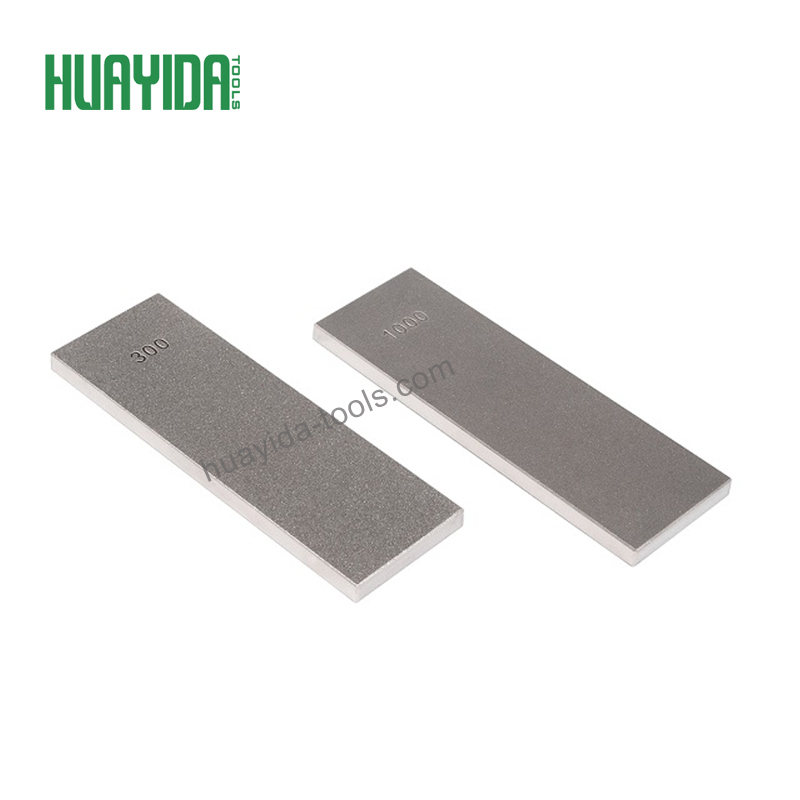 | Double Sided 300 1000 Diamond Sharpening Plate | 300#/1000# | 6"x2"x0.32" (152x50x8 mm) | |
 | Double-Sided Diamond Sharpening Plate for Chisels | 300#/1000# | 7"x2.5"x0.31" (178x65x8 mm) | |
 | Single Side Sharpening Stone Diamond | 400#/1000# | 8"x2.5"x0.31" (205x65x8 mm) | |
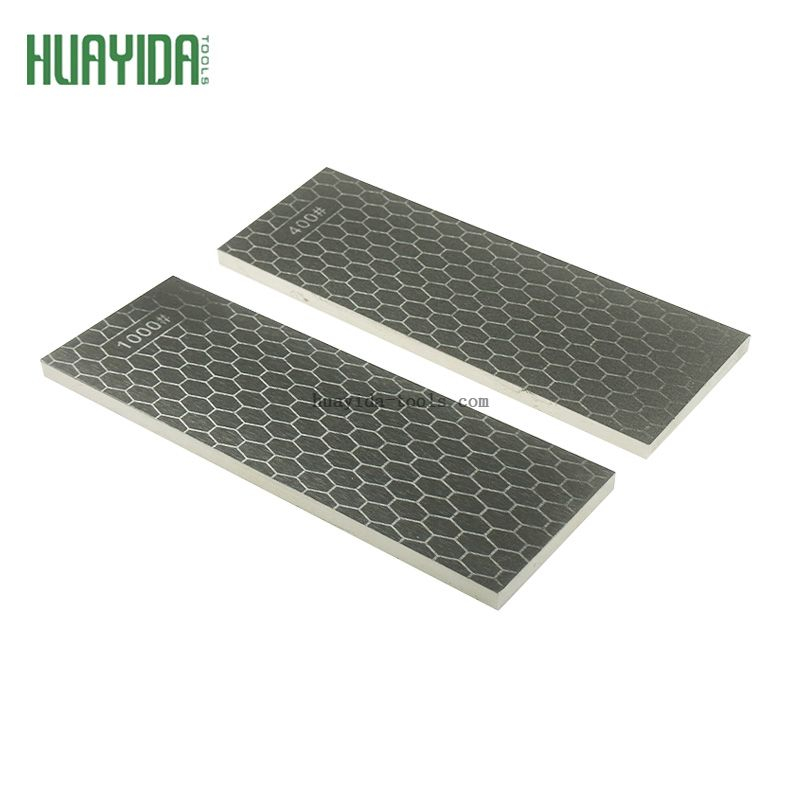 | Diamond Chisel Sharpening Stone | HYD3005--08-4F1F | 400#/1000# | 8"x2.8"x0.31"(203x70x8 mm) |
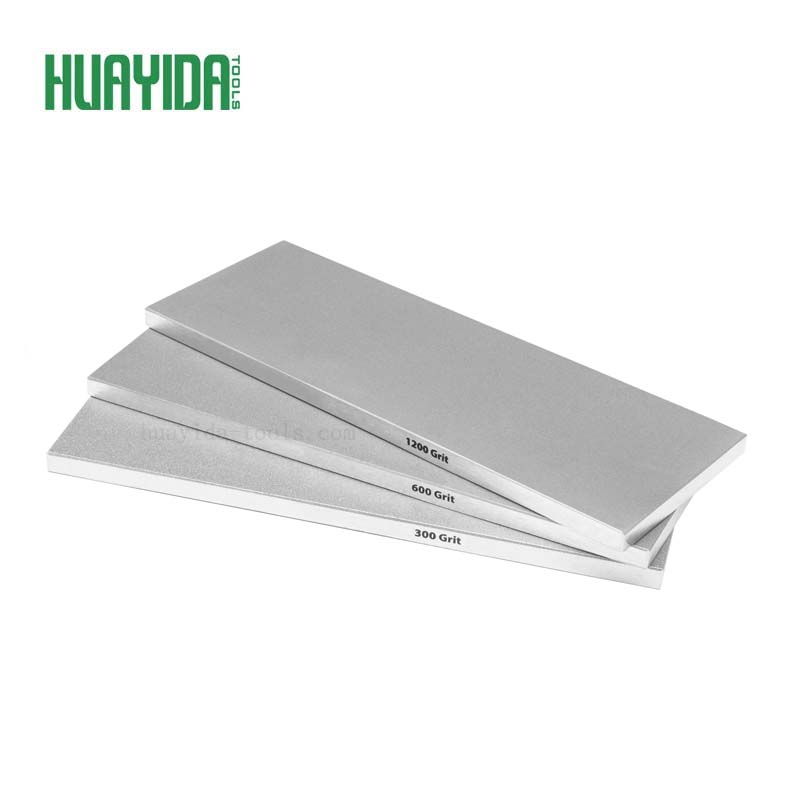 | Single Side Diamond Plate Sharpening Set | HYD3005-8CFE | 300#/600#/1200# | 8"x3"x0.31"(205x75x8 mm) |
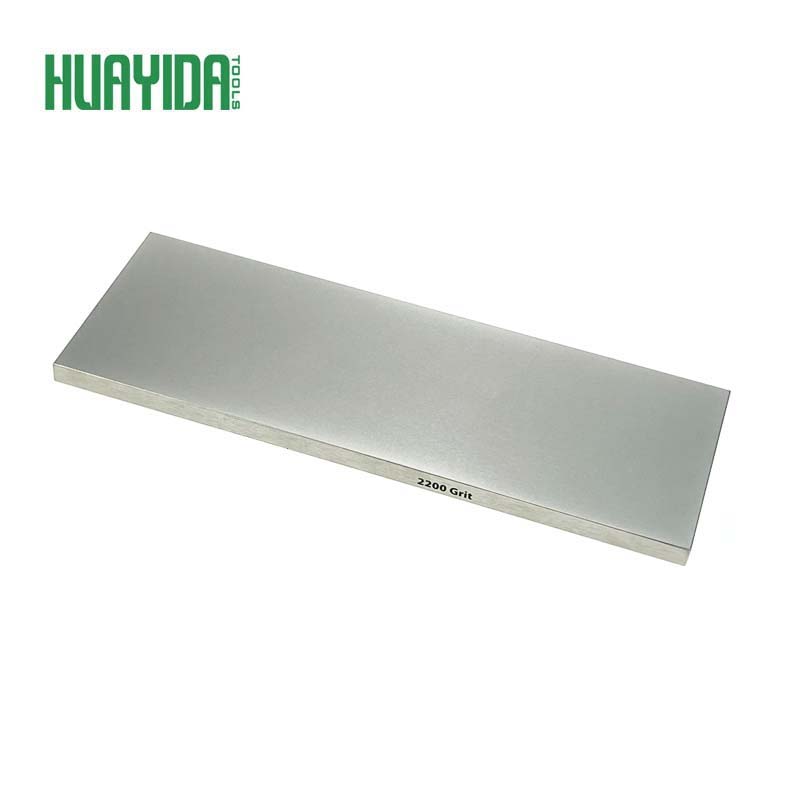 | Diamond Sharpeners 2200 Grit | HYD3005-8EF22 | 2200# | 8"x3"x0.31"(205x75x8 mm) |
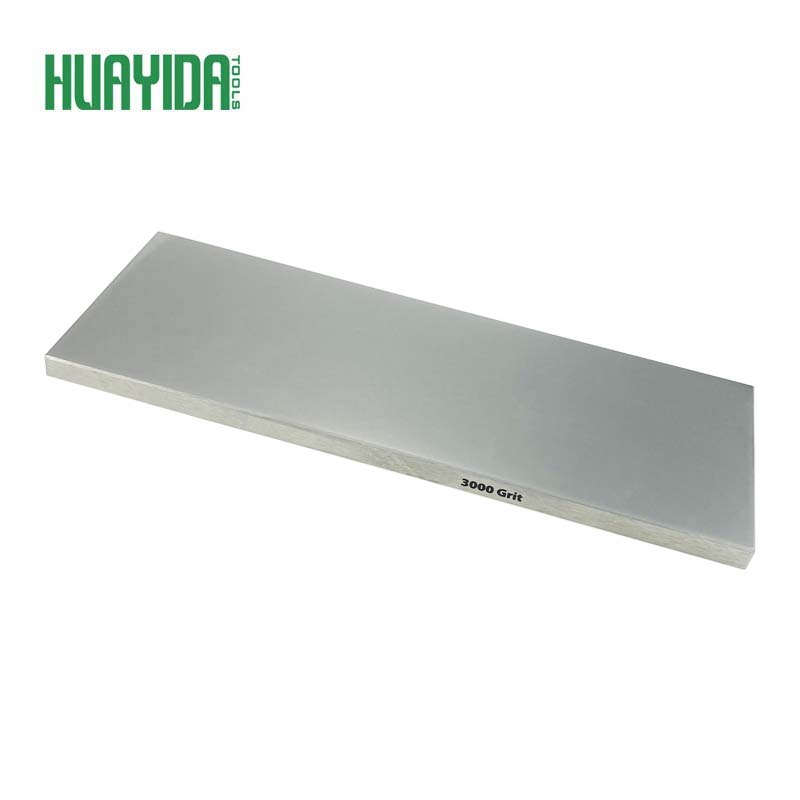 | 3000 Grit Diamond Sharpening Stone | HYD3005-8EF30 | 3000# | 8"x3"x0.31"(205x75x8 mm) |
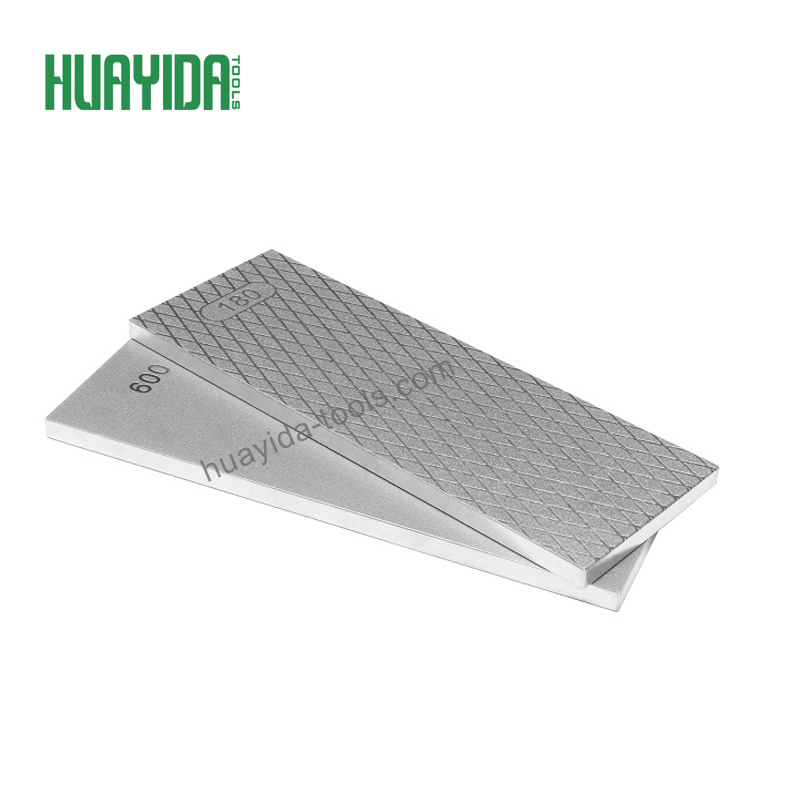 | Double Sided Damond Stone Sharpening | HYD3005--08-18W6P | 180# / 600# | 8"x3"x0.31"(205x75x8 mm) |
 | Double Sided Diamond Whetstone Sharpening Stone | HYD3005--08-3W1P | 300#/1000# | 8"x3"x0.31"(205x75x8 mm) |
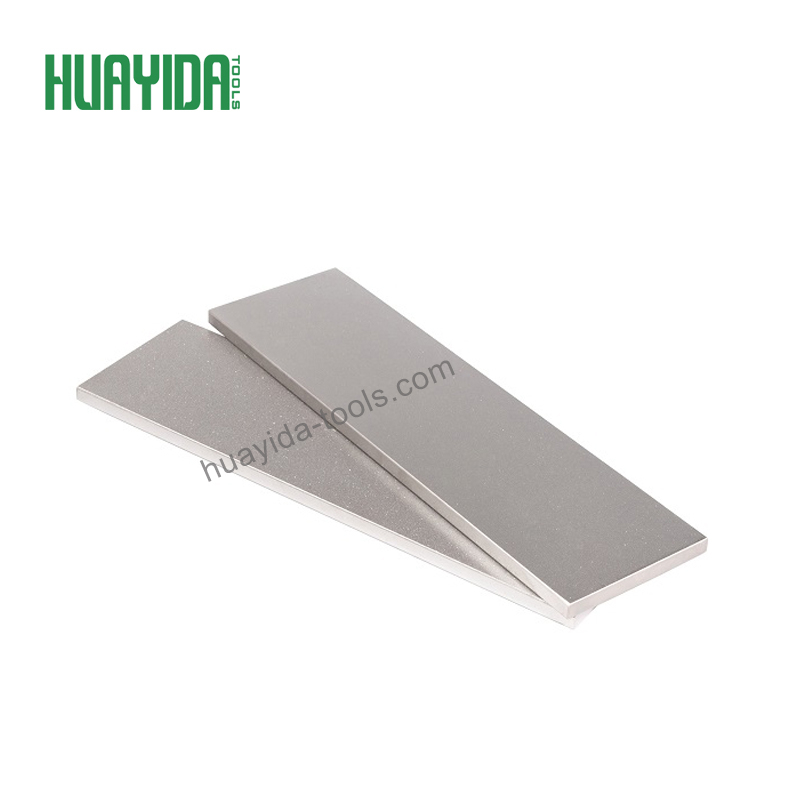 | Diamond Knife Sharpening Stones | HYD3005-09-3P1P | 300#/1000# | 11"x3"x0.31" (260x75x8mm) |
The company has expanded beyond Asia, exporting to Europe and North America. Its sharpeners are now featured in culinary schools in France and Germany and are increasingly popular among professional butchers due to their long lifespan and low maintenance.
This positions HUAYIDA as a serious competitor to long-established brands like DMT and Lansky, especially in terms of cost-to-performance ratio.
A high-quality diamond sharpener can last more than a decade, but only if it’s properly maintained. Many users make the mistake of thinking diamond plates are “maintenance-free.” While they are more durable than waterstones, neglecting cleaning and storage can reduce their lifespan by 30–40%.
After sharpening, metal particles (called swarf) accumulate on the surface. If left uncleaned, these filings clog the abrasive layer and reduce efficiency.
Best Cleaning Method: Rinse the plate with warm water and scrub lightly with a nylon brush.
Alternative: Use a mild dish detergent for stubborn buildup.
Avoid: Harsh chemicals, steel wool, or aggressive scrubbing pads, which can damage the electroplating.
Use water as a lubricant during sharpening—it floats away swarf.
Wipe the plate with a damp microfiber cloth between sharpening sessions.
For heavy use (butcher shops, kitchens), clean plates every 10–15 minutes during continuous sharpening.
Always dry thoroughly after rinsing to prevent rust on steel substrates.
Store flat in a case or protective sleeve.
Avoid stacking multiple plates without padding, as friction can wear the diamond surface.
Industry Fact: According to a 2023 test by the Culinary Edge Institute, diamond plates cleaned after every use maintained 95% abrasive efficiency after 5 years, while plates left uncleaned regularly dropped to 60% efficiency in just 2 years.
Choosing between sharpening stones often comes down to performance, maintenance, and cost-efficiency.
Diamond Stones: 2–4x faster than waterstones. Restore dull edges in minutes.
Waterstones: Moderate speed, but excellent polish.
Oilstones: Slowest option; better suited for tool shaping than knife sharpening.
Diamond: 10+ years with proper care.
Waterstones: Wear down quickly, require flattening every few months.
Oilstones: Medium durability but limited grit options.
While diamond sharpeners cost more upfront, they often outlast 3–5 waterstones. For professionals sharpening daily, this makes diamonds more economical.
| Feature | Diamond Stones | Waterstones | Oilstones |
|---|---|---|---|
| Speed | ★★★★★ | ★★★ | ★★ |
| Durability | 10+ years | 1–3 years | 3–5 years |
| Maintenance | Low | High (soaking + flattening) | Medium (oil use) |
| Edge Quality | Very sharp, consistent | Razor-sharp, polished | Acceptable, less refined |
| Best Use Case | All-purpose, pro kitchens, outdoor tools | Fine finishing, Japanese knives | Tool shaping, woodworking |
Expert Take: For high-hardness steels (S35VN, M390, ZDP-189), only diamond stones provide practical sharpening. Waterstones excel in polishing softer steels, while oilstones are mostly used by traditional woodworkers.

Different sharpening applications require different approaches. Diamond stones excel in versatility:
Chef’s knives, cleavers, paring knives.
Recommended grits: 600 (regular maintenance) → 1200 (razor-sharp edge).
For premium Japanese knives (VG-10, SG2), add 3000+ grit finishing.
Hunting knives, tactical blades, bushcraft tools.
Recommended grits: 325 (reshaping), 600 (field sharpness).
Pocket diamond sharpeners are ideal for on-the-go touch-ups.
Require a 25–30° edge angle for durability.
Recommended grits: 220 (reshaping), 600 (final edge).
Interrupted-surface stones prevent clogging with heavy swarf.
Serrated knives: Use tapered diamond rods.
Scissors: Use flat plates at factory angle.
Carpentry tools (chisels, planes): Diamond bench stones maintain flatness, ensuring precision cuts.
Professional Insight: A 2022 survey of 1,000 chefs worldwide found that 72% preferred diamond stones for their primary sharpening tool, citing speed and consistency as key reasons.
Like any tool, diamond sharpeners have strengths and weaknesses.
Fast sharpening: Reduces time by up to 60%.
Durability: 10+ year lifespan with proper care.
Versatility: Works on all steels, ceramics, and carbide.
Low maintenance: No soaking or flattening required.
Portability: Pocket sharpeners provide field readiness.
Higher upfront cost: Premium brands can cost $150–300.
Aggressive cutting: Can remove more steel than needed if misused.
Limited polishing: Waterstones still outperform diamonds in ultra-fine finishing (8000+ grit).
Feedback feel: Some users find diamond stones less “smooth” than waterstones.
Expert Advice: Combine a diamond stone (600–1200 grit) for fast sharpening with a fine ceramic or waterstone for polishing—this hybrid approach gives the best of both worlds.
Despite their popularity, misconceptions still surround diamond sharpeners. Let’s debunk a few:
Truth: Quality monocrystalline diamond stones can last over 10 years. Cheap polycrystalline stones wear faster, creating this misconception.
Truth: They resist clogging better than waterstones, but swarf buildup reduces efficiency. Proper cleaning is essential.
Truth: Over-aggressive use can remove too much steel, but when used properly, they extend knife lifespan by maintaining precise edges.
Truth: Beginners often find diamond stones easier, as they don’t require soaking, flattening, or complex maintenance.
Truth: Diamonds work dry, with water, or even with specialized honing fluids. Water is preferred for cleanliness; oil is not recommended.
Even with the best diamond sharpener, results depend on technique. Here are industry-proven tips used by professional chefs, bladesmiths, and survival experts:
Use coarse grit (200–400) only when repairing chips or reshaping.
For routine sharpening, 600–1000 grit is ideal.
For razor-sharp finishing, move to 1200–3000 grit.
Use an angle guide if you struggle with freehand sharpening.
Western kitchen knives = 20° per side.
Japanese knives = 15° per side.
Outdoor knives = 22–25° per side for durability.
Let the diamonds do the work. Excessive force wears blades faster and shortens stone lifespan.
Recommended: Apply pressure equivalent to the weight of your hand resting on the blade (~1–2 lbs).
Don’t skip grits—moving step-by-step ensures smoother, longer-lasting edges.
Example progression: 400 → 600 → 1200 → 3000.
Finish with a leather strop or fine ceramic rod to remove micro-burrs.
Stropping improves sharpness retention by up to 30%.
Pro Fact: A controlled test by the Blade Research Institute (2023) found that knives sharpened with diamond stones and finished with stropping retained cutting performance 35% longer compared to knives sharpened without stropping.
The diamond sharpener market offers products across a wide price spectrum. The best choice depends on your sharpening frequency and blade collection.
Best for casual home cooks and outdoor users.
Usually pocket sharpeners or small dual-grit plates.
Examples: Smith’s Combo Sharpener, Sharpal 178N.
Pros: Affordable, portable.
Cons: Smaller surface, fewer grit options.
Best for serious home chefs and hobbyists.
Larger bench stones or guided sharpening systems.
Examples: EZE-LAP, UltraSharp Set, Lansky Deluxe Kit.
Pros: Better grit variety, longer lifespan.
Cons: Requires more sharpening skill than electrics.
Best for professionals, culinary schools, and industrial users.
Large continuous diamond plates or advanced electric sharpeners.
Examples: DMT Dia-Sharp, Chef’s Choice Diamond Hone, Trend Bench Stone.
Pros: Long-lasting, professional precision, fastest sharpening.
Cons: Higher initial cost.
Expert Take: If you sharpen weekly or professionally, invest in a premium system. If you sharpen occasionally, a mid-range sharpener is sufficient. Budget sharpeners are only recommended for light or emergency use.
With increasing global demand, counterfeit sharpeners have entered the market. Buying from trusted suppliers is critical.
Official Brand Websites – DMT, Lansky, HUAYIDA, Chef’s Choice.
Specialty Knife Stores – Both physical and online (e.g., Blade HQ, Knife Center).
Amazon (Authorized Sellers Only) – Check for warranty guarantees.
Industrial Supply Stores – Best for large bench stones and professional-grade systems.
Warning: Avoid cheap unbranded diamond plates on marketplaces. Tests show these lose 50% of abrasive efficiency within 6 months, compared to 5+ years for branded stones.
The world of knife sharpening has evolved—and diamond stone sharpeners are now the gold standard across culinary, outdoor, and industrial applications. They sharpen faster, last longer, and work on virtually every blade material, from stainless steel to high-carbon alloys and even ceramics.
If you want professional-level sharpness with minimal effort, a diamond sharpener is a must-have.
Casual home users → Go for budget or mid-range sharpeners like Sharpal or Smith’s Combo.
Professional chefs and serious hobbyists → Invest in DMT Dia-Sharp or UltraSharp Sets.
Outdoor adventurers → Carry a Work Sharp Field Sharpener or Fallkniven DC4.
Industrial or high-volume use → HUAYIDA or Trend Bench Stones provide unmatched performance and durability.
Ultimately, the best sharpener is the one that matches your blade collection, sharpening frequency, and performance needs.
A high-quality monocrystalline diamond sharpener lasts 10+ years with proper care. Budget options may only last 2–3 years.
They can be used dry, but a splash of water is recommended to prevent clogging. Oil is not necessary and can damage bonding.
Yes, but only high-quality diamond plates (600+ grit) can sharpen ceramic knives effectively.
Yes—especially fine-grit stones (1200–3000). Use light pressure and correct angles (15° per side).
For general kitchen use, 600–1200 grit provides the best balance between edge sharpness and durability.
content is empty!
Contact Us